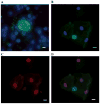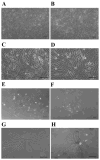Urinary excretion of viable podocytes in health and renal disease
- PMID: 12631553
- PMCID: PMC3368602
- DOI: 10.1152/ajprenal.00404.2002
Urinary excretion of viable podocytes in health and renal disease
Abstract
The loss of glomerular visceral epithelial cells (podocytes) has been associated with the development of glomerular sclerosis and loss of renal function. Viability of podocytes recovered from urine of subjects with glomerular disease and of healthy controls was investigated by propidium iodide exclusion and TUNEL staining. Podocyte loss was quantified by cytospin. The growth behavior in culture of urinary cells and their expression of specific markers were examined. The majority of urinary podocytes are viable, although apoptosis occurs in about one-half of the cells. Patients with active glomerular disease excreted up to 388 podocytes/mg creatinine, whereas healthy controls and patients with quiescent disease generally excreted <0.5 podocytes/mg creatinine. The identity of cultured cells was confirmed by their morphology, growth behavior, and expression of podocyte-specific markers. The difference in growth behavior between healthy controls and subjects with active glomerular disease suggests that in active disease viable podocytes detach from the glomerular tuft due to local environmental factors rather than defects in the podocytes per se, whereas in healthy individuals mostly senescent podocytes are shed.
Figures







References
-
- Drumond MC, Deen WM. Structural determinants of glomerular hydraulic permeability. Am J Physiol Renal Fluid Electrolyte Physiol. 1994;266:F1–F12. - PubMed
-
- Endlich K, Kriz W, Witzgall R. Update in podocyte biology. Curr Opin Nephrol Hypertens. 2001;10:331–340. - PubMed
-
- Fries JW, Sandstrom DJ, Meyer TW, Rennke HG. Glomerular hypertrophy and epithelial cell injury modulate progressive glomerulosclerosis in the rat. Lab Invest. 1989;60:205–218. - PubMed
-
- Hara M, Yamamoto T, Yanagihara T, Takada T, Itoh M, Adachi Y, Yoshizumi A, Kawasaki K, Kihara I. Urinary excretion of podocalyxin indicates glomerular epithelial cell injuries in glomerulonephritis. Nephron. 1995;69:397–403. - PubMed
Publication types
MeSH terms
Substances
Grants and funding
LinkOut - more resources
Full Text Sources
Other Literature Sources

